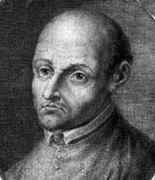Person: Maurolico, Francesco

Francisco Maurolico was an Italian Benedictine who wrote important books on Greek mathematics. He also worked on geometry, the theory of numbers, optics, conics and mechanics.
Mathematical Profile (Excerpt):
- However, he also learned much from Francesco Faraone, a priest in Messina, who taught him grammar and rhetoric.
- Thus Maurolico would believe in approaching problems using his intellect, and using his own practical experience.
- Maurolico left the city for a while to escape from the deadly illness.
- Maurolico was able to concentrate on his scholarly pursuits during these years and he produced significant contributions in a broad range of different topics although his best work was done on mathematics.
- Certainly he was not a wealthy man and required patrons to be able to publish his work and several leading men of Messina appear to have put up funds since their names appear in dedications in Maurolico's work.
- The governor attended Maurolico's lectures on these topics.
- Perhaps as a result of these lectures, Maurolico wrote up his rearrangement and translation of part of Euclid's Elements and completed the task on 9 July 1532.
- Another of Maurolico's patrons was Giovanni Ventimiglia, 6th Marchese di Geraci, Prince of Castelbuono (a town in the province of Palermo, Sicily), and Governor of Messina.
- As a Benedictine, Maurolico would have a life of simplicity, a feature that was much loved by the people.
- After several years in the Abbey in Castelbuono, Maurolico returned to Messina where he was appointed as an abbot in the cathedral.
- Maurolico was involved in the mathematical curriculum that was set up in the College being appointed as professor of mathematics in 1569.
- Maurolico was also mathematics tutor to one of Giovanni de Vega's two sons.
- Maurolico wrote important books on Greek mathematics, restored many ancient works from scant information and translated many ancient texts such as those by Theodosius, Menelaus, Autolycus, Euclid, Apollonius and Archimedes.
- The work contains nine separate items by Maurolico, some translations, some commentaries, and a work of his own De Sphaera Sermo.
- Maurolico also worked on geometry, the theory of numbers (L E Dickson notes some of his results), optics, conics and mechanics, writing important books on these topics which we will discuss in more detail below.
- Both Guglielmo Libri and Gino Loria claimed that this achievement alone showed that Maurolico was a genius.
- Maurolico gave methods for measuring the Earth in Cosmographia which were later used by Jean Picard in measuring the meridian in 1670.
- Maurolico made astronomical observations, in particular he observed the supernova which appeared in Cassiopeia in 1572 now known as 'Tycho's supernova'.
- Some details of Maurolico's observations were published by Christopher Clavius but full details of Maurolico's observations were never published and only rediscovered in 1960 by C Doris Hellman.
- Perhaps there is an argument for renaming 'Tycho's supernova' as 'Maurolico's supernova'.
- By 1569 Maurolico was making considerable efforts to have a collection of his unpublished work printed.
- please find out from the bookseller Giovanni Comisino what he has done about the printing of Abbot Maurolico's books, because Sicily asks us about them.
- Christopher Clavius visited Maurolico in 1574 and Maurolico gave him various manuscripts of his optical works under the title Photismi de lumine, et umbra.
- By November 1574 the Opuscula Mathematica was in press but there must have been a further delay since when the work was published it did not contain Maurolico's dedication to the governor of Messina but rather a dedication written by the publisher dated 26 July 1575, four days after Maurolico's death.
- The Opuscula Mathematica contains seven of Maurolico's treatises including De instrumentis astronomicis on the theory and use of the principal astronomical instruments.
- In the proof of this last Proposition, Maurolico makes clear use induction.
- Maurolico's interests were not restricted to science.
- They had inherited several of Maurolico's unpublished works which they published together with the biography Vita dell'Abbate del Parto D Francesco Maurolico written by Francesco.
- Perhaps the most significant of Maurolico's works to be published at this time was Problemata mechanica originally completed in 1569.
- Although Maurolico preferred to ground his mechanics in Archimedean statics, he nevertheless recognized the application of mechanics beyond conditions of equilibrium, to the motion of heavy bodies - the moving of weights with machines and the harnessing of impetus.
- We should not think that all these posthumous publications complete the printing of Maurolico's treatises.
- Maurolico completed this work in 1534.
Born 16 September 1494, Messina, Kingdom of Sicily (now Italy). Died 22 July 1575, Messina, Kingdom of Sicily (now Italy).
View full biography at MacTutor
Tags relevant for this person:
Origin Italy, Special Numbers And Numerals
Mentioned in:
Parts: 1
Thank you to the contributors under CC BY-SA 4.0! 

- Github:
-

- non-Github:
- @J-J-O'Connor
- @E-F-Robertson
References
Adapted from other CC BY-SA 4.0 Sources:
- O’Connor, John J; Robertson, Edmund F: MacTutor History of Mathematics Archive
